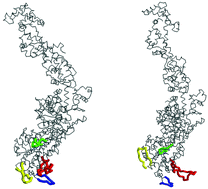Conformational flexibility of loops of myosin enhances the global bias in the actin–myosin interaction landscape†
Abstract
A long-standing controversy on the mechanism of an actomyosin motor is the role of the Brownian motion of the myosin head in force generation. In order to shed light on this problem, we calculate free-energy landscapes of interaction between an actin filament and the head (S1) of myosin II by using a coarse-grained model of actomyosin. The results show that the free-energy landscape has a global gradient toward the strong-binding site on actin filament, which explains the biased Brownian motion of myosin S1 observed in a single-molecule experiment [Kitamura et al., Nature, 1999, 397, 129 and Biophysics, 2005, 1, 1]. The distinct global gradient in the landscape is brought about only when the conformation of loop 2 at the actin interface of myosin S1 is flexible. The conformational flexibility of loop 3 also contributes to the gradient in the landscape by compensating the role of loop 2. Though the structure of loop 2 is expanded in the weak-binding state, loop 2 shows the larger fluctuation of compaction and expansion due to the actin–myosin interactions as myosin S1 moves toward the strong-binding site on actin filament. Hence, the increase in the compaction–expansion fluctuation of loop 2, the stronger binding of myosin to actin, and the biased Brownian motion of myosin S1 are coupled with each other and should take place in a concurrent way. This predicted coupling should provide opportunities to further test the hypothesis of the biased Brownian motion in actomyosin.

- This article is part of the themed collection: The free energy landscape: from folding to cellular function

 Please wait while we load your content...
Please wait while we load your content...